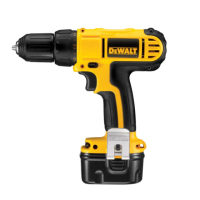English
8
charger from the power supply when
there is no battery pack in the cavity.
Unplug charger before attempting to
clean.
• DONOTattempttochargethebatterypack
with any chargers other than the ones in
this manual. The charger and battery pack are
specifically designed to work together.
• Thesechargersarenotintendedfor
any uses other than charging DeWALT
rechargeable batteries. Any other uses
may result in risk of fire, electric shock or
electrocution.
• Donotexposechargertorainorsnow.
• Pullbyplugratherthancordwhen
disconnecting charger. This will reduce risk
of damage to electric plug and cord.
• Makesurethatcordislocatedsothatit
will not be stepped on, tripped over, or
otherwise subjected to damage or stress.
• Donotuseanextensioncordunlessit
is absolutely necessary. Use of improper
extension cord could result in risk of fire,
electric shock, or electrocution.
• Donotplaceanyobjectontopofcharger
or place the charger on a soft surface that
might block the ventilation slots and result
in excessive internal heat. Place the charger
in a position away from any heat source. The
charger is ventilated through slots in the top and
the bottom of the housing.
• Donotoperatechargerwithdamagedcord
or plug — have them replaced immediately.
• Donotoperatechargerifithasreceived
a sharp blow, been dropped, or otherwise
damaged in any way. Take it to an authorized
service center.
• Donotdisassemblecharger;takeittoan
authorized service center when service or
repair is required. Incorrect reassembly may
result in a risk of electric shock, electrocution or
fire.
• Disconnectthechargerfromtheoutlet
beforeattemptinganycleaning.Thiswill
reduce the risk of electric shock. Removing
the battery pack will not reduce this risk.
• NEVERattempt to connect 2 chargers together.
• Thechargerisdesignedtooperateon
standard230Vhouseholdelectricalpower.
Do not attempt to use it on any other
voltage. This does not apply to the vehicular
charger.
Save tHeSe inStructionS
Chargers
Your DE9116 charger accepts DeWALT NiCd and
NiMH battery packs ranging from 7.2 V to 18 V.
Your DE9118 charger accepts DeWALT NiCd battery
packs ranging from 7.2 V to 14.4 V.
The DE9135 charger accepts 7.2 to 18 V NiCd,
NiMH or Li-Ion batteries.
These chargers require no adjustment and are
designed to be as easy as possible to operate.
Charging Procedure (fig. 2)
DANGER: Electrocution hazard.
230 volts present at charging terminals.
Do not probe with conductive objects.
Danger of electric shock or
electrocution.
1. Plug the charger (k) into an appropriate outlet
before inserting battery pack.
2. Insert the battery pack into the charger. The red
(charging) light will blink continuously indicating
that the charging process has started.
3. The completion of charge will be indicated by
the red light remaining ON continuously. The
pack is fully charged and may be used at this
time or left in the charger.
NOTE: To ensure maximum performance and life of
NiCd, NiMH and Li-Ion batteries, charge the battery
for a minimum of 10 hours before first use.
Charging Process
Refer the table below for the state of charge of the
battery pack.
State of charge
charging – – – –
fully charged –––––––––––
hot/cold pack delay –– – –– –
replacebatterypack •••••••••••
problem •• •• •• ••
Automatic Refresh
(DE9116, DE9135)
The automatic refresh mode will equalise or balance
the individual cells in the battery pack at its peak
capacity. Battery packs should be refreshed weekly
or whenever the pack no longer delivers the same
amount of work.

